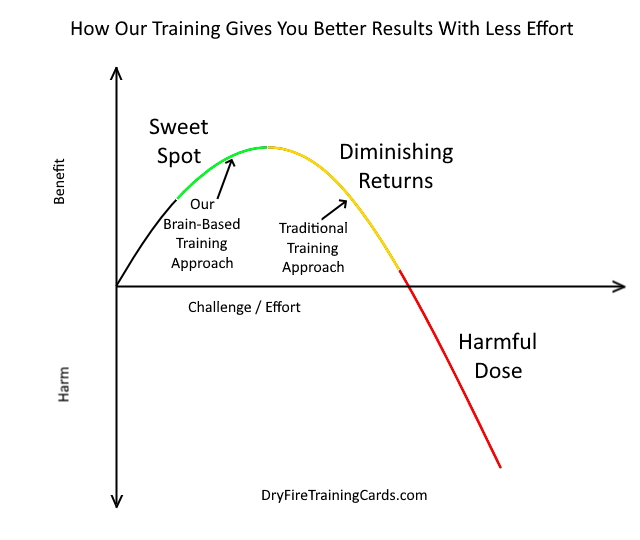A friend of mine asked an awesome question the other day on when to speed up during dry fire…when to push yourself.
The truth is, the majority of shooters are either training way FASTER than they should or way SLOWER than they should and don’t know how to tell.
There are 3 different answers to keep in mind…
- Initial skill learning.
- Skill development/practice/training
- Performance
With initial skill learning, you want to do reps at a speed where you can succeed 100% of the time…whatever speed that may be.
“Succeeding 100% of the time” is kind of a fuzzy target. It depends on the size of the target, distance to the target, and time constraints that you get to decide.
When you can be successful 100% of the time without effort and/or practicing the basic skill is so unengaging that your mind wanders, it’s time to switch to phase 2.
I go into more detail on this in Real World Gunfight Training, but in phase 2, you want to adjust your training so that you’re making about 80% hits the majority of the time. This would be the “sweet spot” in the graph below:

100% success would place you in the black…it’s not stimulating enough. The HUGE error-correction parts of the brain that we depend on in chaotic situations aren’t engaged and our training becomes “fragile” rather than “resilient.”
50%-70% would put you in the yellow…you’re working harder for less and less benefit.
Less than 50% would put you in the red, where you’re rewarding random performance. < Training in the red zone is cruel, because it strokes the ego when you do “really hard” workouts. There’s also a phenomenon where each time you fail, you build up the amount of dopamine that will be released when you succeed. So you can get a bigger rush when you’re failing more, but unless you know what you did differently to succeed and can repeat it, you’re rewarding random performance.
But that 80% range will give you the most skill (and the most resilient skill) for the least amount of effort.
Performance is the 3rd thing to keep in mind. Know how much you need to back off in order to succeed 100% of the time.
Hold on for the irony…
You want to do a little bit of training in each zone every time you practice.
Start easy, with a few 100% hits.
Do the bulk of your training in that 80% range.
Push things a little to find your limits for a few reps.
Go back to that 80% range.
End easy, with a few 100% hits.
If you do it right, you can get that all in in 5-15 minutes.
If you’ve got enough time, you can definitely figure this out on your own, but what we’ve seen through the years is that MOST dry fire drills that people learn from their favorite Youtoober or dry fire book will actually create training scars and actually slow down how quickly you build real-world skill.
Real World Gunfight Training and Praxis are two HUGE, industry leading exceptions to this.
Real World Gunfight Training will show you how to create your own gunfight training system and Praxis will hand you the system on a silver platter with 50+ at-home, follow-along, dry fire training workouts (like a workout video) purpose-built for self-defense shooting.
One of the things that I tell people is that, if you’ve got time to burn, then buy a bunch of doodads, watch a bunch of YouTube videos, read a bunch of mainstream gun training articles, and ask the “counter-intelligence” at your local gun store what to do.
If you’re pressed for time, already have a full schedule, and don’t have money to waste, but know that you need to have the skills your loved ones expect you to have, then you want a curated, tested, and FAST training system, like >Praxis<.
Questions? Comments? Fire away by commenting below.

Leave A Response